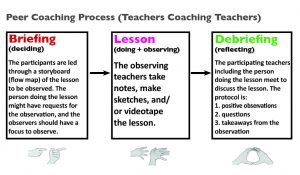No matter what accomplishments you make, somebody helped you.
—Althea Gibson
Peer to Peer Coaching
The Peer to Peer Coaching model focuses on educators regularly observing each other to learn, understand, and improve their pedagogy (teaching methods with the how of teaching). This model works best in small groups with a minimum of three – one teacher demonstrating a lesson while two other teachers observe. The observed lessons are generally in the 15-30 minute range to provide a focus on particular teaching methods. The model includes a briefing, lesson and debriefing. It is recommended to group teachers from different grade levels and subject areas so they are focused on the teaching methods and not only content.
Download the PDF file for implementing Peer to Peer Coaching with Research
Briefing (approximately 5 minutes)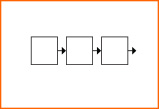 The teaching educator provides a sequence of the lesson they will be doing with the students for the observing educators. This provides a concise overview of the lesson. Each of the observers share something they will be focusing on (which could be added as part of the frame for the sequence/flow map). Research has shown that having a specific thing to focus on elevates the quality of being an observer. The teaching educator might also request something specific to observe. The lesson can be done with the teaching educator’s own class, and even changing it up doing the lesson in another colleagues classroom so they are with different students. This provides the teacher whose classroom it is in to observe their students with another teacher. It is important to let the teacher teaching be responsible for all in the classroom.
The teaching educator provides a sequence of the lesson they will be doing with the students for the observing educators. This provides a concise overview of the lesson. Each of the observers share something they will be focusing on (which could be added as part of the frame for the sequence/flow map). Research has shown that having a specific thing to focus on elevates the quality of being an observer. The teaching educator might also request something specific to observe. The lesson can be done with the teaching educator’s own class, and even changing it up doing the lesson in another colleagues classroom so they are with different students. This provides the teacher whose classroom it is in to observe their students with another teacher. It is important to let the teacher teaching be responsible for all in the classroom.
Lesson (approximately 15-30 minutes)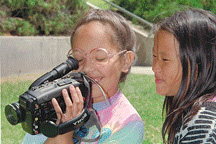 The lesson includes the teacher debriefing the students reflectively at the end of the lesson on the tools they used. It is highly recommended to have all observers take notes of what they are observing. Additionally, it is helpful to video the lesson (camera mostly on the students) so the video can be used in the debriefing. That way we know what we think we saw in reviewing the lesson again. It provides a reflective tool to see the finer points of the lessons.
The lesson includes the teacher debriefing the students reflectively at the end of the lesson on the tools they used. It is highly recommended to have all observers take notes of what they are observing. Additionally, it is helpful to video the lesson (camera mostly on the students) so the video can be used in the debriefing. That way we know what we think we saw in reviewing the lesson again. It provides a reflective tool to see the finer points of the lessons.
Debriefing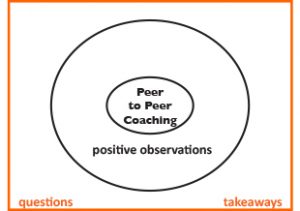 The debriefing follows the protocol of
The debriefing follows the protocol of
1. The name of the educator teaching in the middle;
2. Positive observations;
2. Questions;
3. Takeaways.
It is supportive of the process to use a visual tool – e.g. a Circle Map with a Frame (Thinking Maps®) to help with the processing of information.
The name of the educator teaching goes in the middle;
The map is for the educator who was teaching the lesson to keep, as is any video recording. Only with the permission of the teaching educator should the video be shared outside the group of colleagues.
See the video overview and video examples below.
Download the PDF file for implementing Peer to Peer Coaching with Research
This model is a multi-directional process: everyone has gifts and skills to share and learn from one another. This differentiated process allows everyone to progress at a rate consistent with their skills. The model is an ongoing process for both new and experienced teachers.
Ongoing Development: Teachers regularly participant with the Peer to Peer Coaching model throughout the school year. Weekly or every other week would be recommended.
Use a Circle Map and Frame of Reference as a tool to observe a lesson with using the Frame of Reference to align the observations with the implementation of High Operational Practices (HOPs).
Download PDF file of the image below (2 to a page)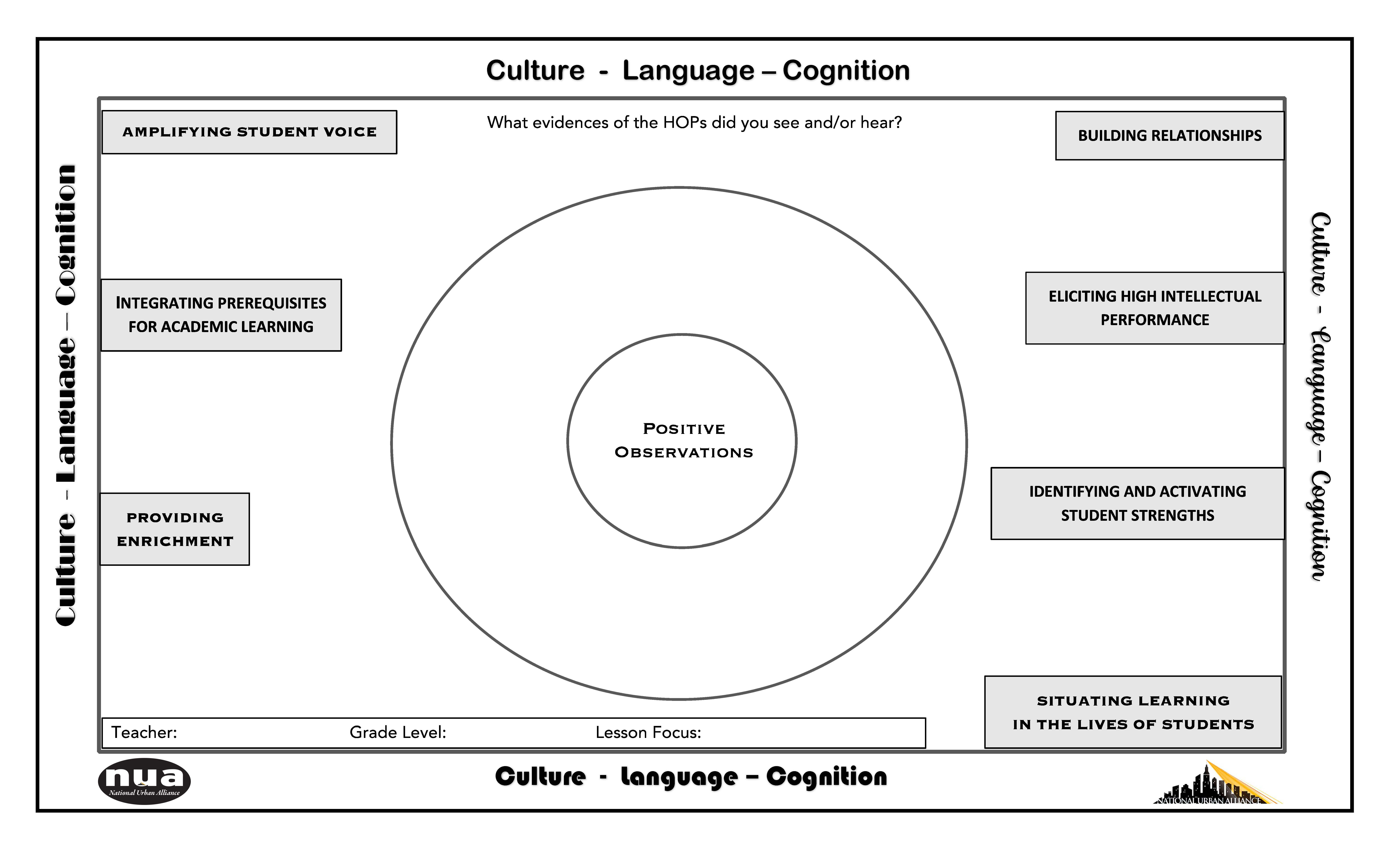 Download PDF file of the image above (2 to a page)
Download PDF file of the image above (2 to a page)
Changing It Up
We are all professionals, so it also is highly suggested to collaborate across grade levels, across content areas and in different schools as well. The pandemic having us use virtual learning such as Zoom has provided a model of how we can use virtual collaborations in a highly effective manner as well. This includes early elementary educators and upper level educators observing one another’s pedagogy in action.
This model is equally effective with administrators coaching administrators; facilitators coaching facilitators, staff coaching staff and so forth.
Download the PDF file for implementing Peer to Peer Coaching with Research
Research
Peer Coaching That Works
The Power of Reflection and Feedback in Teacher Triad Teams
By Robin Jarvis, Kathleen Dempsey, Grace Gutierrez, Dale Lewis, Kris Rouleau, and Bj Stone
Journal of Interdisciplinary Research in Education, 2017, McREL International
Much has been written over the past two decades about the value of coaching to teachers’ professional growth. Many authors recommend specific coaching models while others primarily make recommendations for building strong, trusting coaching relationships (Knight, 2007, 2009; Hirsh & Killion, 2007; Hall & Simeral, 2008, 2015; Aguilar, 2013; Kise, 2006; Killion & Harrison, 2006; Killion, Knight, & Barkley, 2005; Joyce & Showers, 2002; Showers, 1985; Shalaway, 1985). However, many of these models assume a deficit-based approach to teacher development that relies on an expert coach to address a teacher’s identified areas for improvement. At McREL, we believe that this deficit-based approach to teacher development, coupled with the recent push to use teacher evaluation to make high-stakes employment decisions rather than as a tool for growing teacher professional practice, is leading to increasing teacher burnout and shortages as more and more teachers leave the field under the constant pressures to improve.
Download the PDF file
Getting to the Heart of System Reform
A micro strategy for large scale educational change
Educationalfutures, Hopkins and Baumber Vol.10(2) Dec 2019
David Hopkins, Director, The International Centre for Educational Leadership and School Improvement, University of Bolton.
John Baumber, Director, The International Centre for Educational Leadership and School Improvement, University of Bolton.
There is a paradox at the heart of contemporary system change in education. On the one hand there is the unequivocal conclusion from the accumulation of PISA evidence for example, that both excellence and equity are possible at a system level; yet on the other hand there are concerns from most educational jurisdictions over the stubbornness of low standards. Why is it that despite the phenomenal increase in our recent knowledge about what works in schooling, that standards still lag behind expectations and school level performance is far too variable. The paper addresses this paradox and concludes that unless we focus unrelentingly on the quality of teaching in both our small and large-scale reform efforts, then current practice will never meet society’s expectations. A ‘micro-strategy’ for sustained systemic educational change, generally known as ‘Instructional Rounds’, is described. This strategy for pedagogic improvement has the potential for generating an increasingly specific language for teaching and learning that significantly aids consistency and precision in the quest for both excellence and equity. The argument concludes by proposing a school improvement strategy for moving Instructional Rounds, the generation of Theories of Action and Peer Coaching to scale. This has particular relevance for school networks and Multi Academy Trust and has the potential of having has the potential of having large-scale system reform impact.
Download the PDF file
Peer Coaching for Improvement of Teaching and Learning
Journal of Interdisciplinary Research in Education (JIRE) ISSN 2232-0180, Vol. 6, Issue 1, 2016, pp. 64-70, Liew Wai Yee, Taylor’s College Sri Hartamas, Malaysia.
Keywords: Peer Coaching, observation, self-reflection, professional development, mentoring
Abstract: This report reflects on the experience of conducting peer coaching for improvement of teaching practices and student learning. Peer coaching was first conducted by the Science Department offering Cambridge A-Level Programme on two Semester One classes. The observed lesson was targeted on engaging students through collaborative learning. Another experience on peer coaching was conducted by a group of teachers from different subjects and programmes, and targeted on learning by using formative assessment. The model attempted was the collegial peer coaching, and it included three main processes: pre-observation planning and discussion, two consecutive peer observations, and post-observation discussion. Peer coaching was found to be an impactful tool for professional development, because it offers teachers the opportunity for self-reflection, sharing of classroom experience, and mutual growth in teaching.
Download the PDF file
The Evolution of Peer Coaching
Beverly Showers; Bruce Joyce
Educational Leadership, March 1996 v53 n6 p12(5)
Today, peer coaching study teams enhance staff development efforts and offer support for teachers implementing new strategies. Fifteen years have passed since we first proposed peer coaching as an on-site dimension of staff development (Joyce and Showers 1980). In the 1970s, evaluations of staff development that focused on teaching strategies and curriculum revealed that as few as 10 percent of the participants implemented what they had learned. Rates of transfer were low even for those who had volunteered for the training. Well-researched curriculum and teaching models did not find their way into general practice and thus could not influence students’ learning environments.
Download the PDF file

